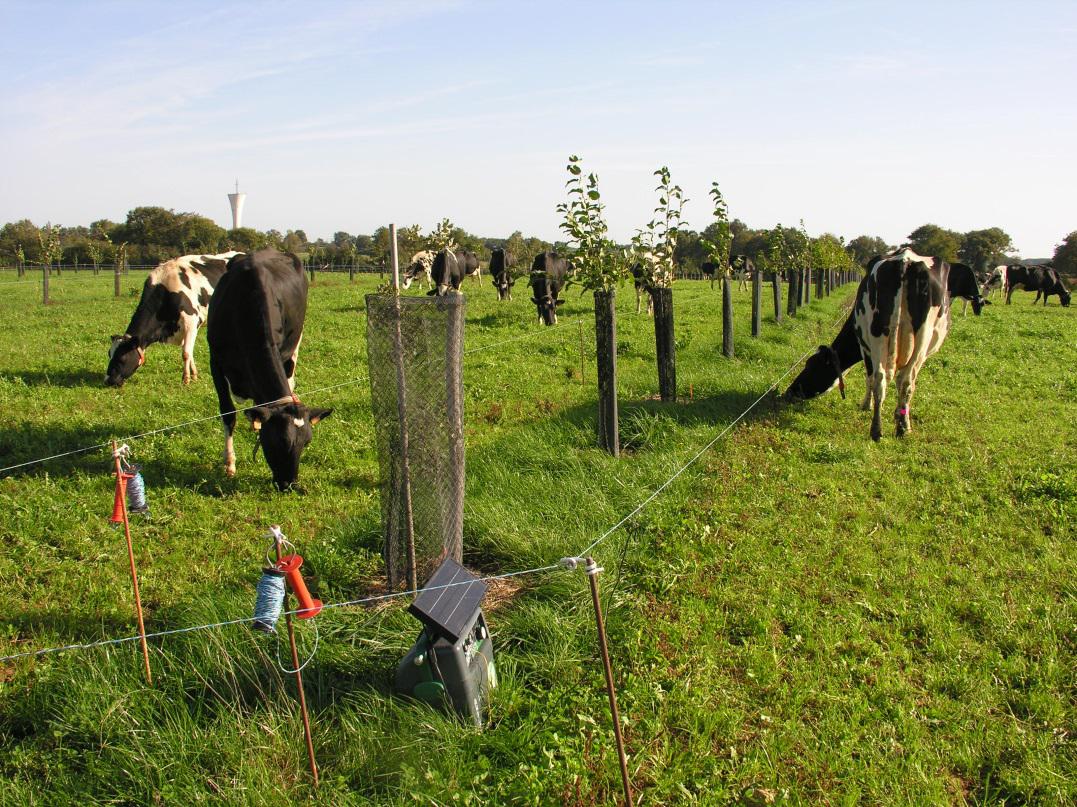
Αγροδασοπονία με μηρυκαστικά ζώα στη Γαλλία
Περιγραφή του συστήματος
Ερευνητικοί σταθμοί και επιλεγμένοι αγρότες στη Γαλλία έχουν διερευνήσει τη δυνατότητα ενσωμάτωσης δένδρων στην παραγωγή βοοειδών, προβάτων και αιγών.
Αρχική συνάντηση ενδιαφερόμενων φορέων
Την αρχική συνάντηση των ενδιαφερόμενων φορέων στη Βόρεια Γαλλία, την 1η Ιουλίου 2014, ακολούθησε μια δεύτερη στο Πειραματικό Κέντρο Lusignan του INRA, στις 28 Αυγούστου 2014. Συνολικά και στις δύο συναντήσεις έλαβαν μέρος 27 συμμετέχοντες. Η βελτίωση της ευημερίας των ζώων και η βελτιωμένη εικόνα των γεωργών θεωρήθηκαν ως βασικές θετικές απόψεις της αγροδασοπονίας με βοοειδή, πρόβατα και αίγες. Ως βασικές αρνητικές απόψεις θεωρήθηκαν η πολυπλοκότητα του συστήματος και ο φόρτος εργασίας. Ως πιθανές περιοχές έρευνας εντοπίστηκαν η προστασία των δένδρων από τα ζώα, τη χωροθέτηση των δένδρων για η βελτιστοποίηση της παραγωγής βοσκήσιμης ύλης και την ευημερία των ζώων, το θρεπτικό πλεονέκτημα της βοσκήσιμης ύλης των δένδρων και η αξιολόγηση των τεχνικών και οικονομικών πλευρών τέτοιων συστημάτων.
Αν επιθυμείτε να μάθετε περισσότερα για τη δραστηριότητα αυτής της ομάδας, παρακαλούμε να επικοινωνήσετε με τον EricPottier (eric.pottier@idele.fr).
Κατεβάστε την αρχική έκθεση ενδιαφερόμενων φορέων
Κατεβάστε το αρχικό πρωτόκολλο έρευνας και ανάπτυξης
Κατεβάστε την περιγραφή του συστήματος
Μία έκθεση περιγραφής του συστήματος που περιέχει και μία ανασκόπηση της αγροδασικής έρευνας σχετικής με τα μηρυκαστικά ζώα στη Γαλλία ετοιμάστηκε τον Δεκέμβριο του 2015.
Lessons learnt
In July 2017, Sandra Novak and Eric Pottier summarised the lessons learnt from their research of agroforestry with cattle in France. The research on tree protection at the experimental site at INRA Lusignan showed that electric fencing and metal fences are effective in controlling cattle damage to the trees. However it was also necessary to use strong mesh guards on each individual tree to limit the damage from deer. Planting trees in double or triple rows was more effective (in terms of costs and weed control) than planting single rows. It was also noted that although the trees will provide production benefits in the medium to long-term, the “up-front” costs are significant.
A study of the effect of the young trees on pasture production showed that although grass production was reduced near the trees; the pasture production from the agroforestry and the (no trees) control plots was similar at a plot level. The trees tended to reduce the dominance of clover (Trifolium repens) and increase the dominance of perennial ryegrass (Lolium perenne).
The research also examined the nutritive value of the leaves of 10 tree, shrub or liana species relative to alfalfa. The crude protein concentration varies from less than 85 g kg-1 in holm oak to more than 220 g kg-1 in black locust, chestnut, ash and white mulberry. Both white mulberry (Morus alba) and common ash (Fraxinus excelsior) have sufficient digestibility and nitrogen degradability to be included in the diet of lactating cows in mixed crop-livestock systems.